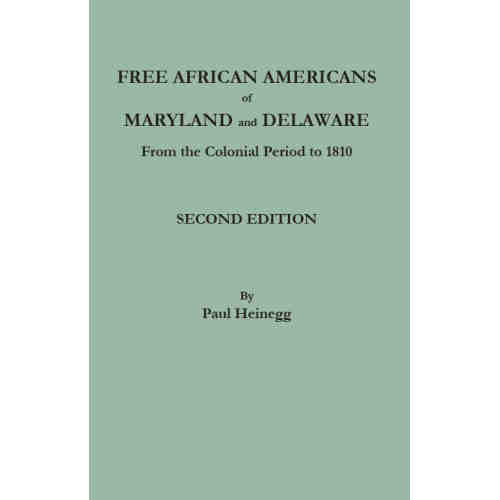Description
In this second edition of his acclaimed work, Paul Heinegg has continued reconstructing the history of the free African American communities of Maryland and Delaware by looking at the history of their families.
Free African Americans of Maryland and Delaware is a work that will intrigue genealogists and historians alike. First and foremost, Mr. Heinegg has assembled genealogical evidence on more than 400 Maryland and Delaware black families (naming nearly 10,000 individuals), with copious documentation from the federal censuses of 1790-1810 and colonial sources consulted at the Maryland Hall of Records, county archives, and other repositories. In fact, the author has examined all extant court records for Maryland and Delaware for the period under investigation. No work that we know of brings together so much information on colonial African Americans, except Mr. Heinegg’s three-volume series volume on Virginia, North Carolina, and South Carolina. This second edition of Free African Americans of Maryland and Delaware from the Colonial Period to About 1810 is nearly 60% larger than the original.
The author offers documentation proving that most of these free black families descended from mixed-race children who were themselves the progeny of white women and African American slaves or free blacks. In all, Heinegg proves that these families descended from 264 white women who had had 374 mixed-race children. He has also identified another 112 white women who bore 127 mixed-race children for whom no direct evidence of offspring could be found. While some of these families would claim Native American ancestry, Mr. Heinegg offers evidence to show that they were instead the direct descendants of mixed-race children.
Colonial Maryland laws relating to marriages between offspring of African American and white partners carried severe penalties. For example, one 18th-century statute threatened a white mother with seven years of servitude and promised to bind her mixed-race offspring until the age of thirty-one. Mr. Heinegg shows that, despite these harsh laws, several hundred child-bearing relationships in Delaware and Maryland took place over the colonial period, as evidenced directly from the public record. Maryland families, in particular, which comprise the preponderance of those studied, also had closer relationships with the surrounding slave population than did their counterparts in Delaware, Virginia, or the Carolinas. Mr. Heinegg recounts the circumstances under which a number of these freedmen were able to become landowners. Some Maryland families, however, including a number from Somerset County, chose to migrate to Delaware or Virginia, where the opportunities for land ownership were greater. For example, the freeman John Johnson, of Somerset County, patented 400 acres in Rehoboth Bay, Sussex County, Delaware in 1677. Other Maryland families who settled in Kent County, Delaware, included Butcher, Fountain, Gibbs, Grinnage, Lacount, Norman, Parsons, Plummer, Poulson, Proctor, Roach, Saunders, and Toogood.







Reviews
There are no reviews yet.